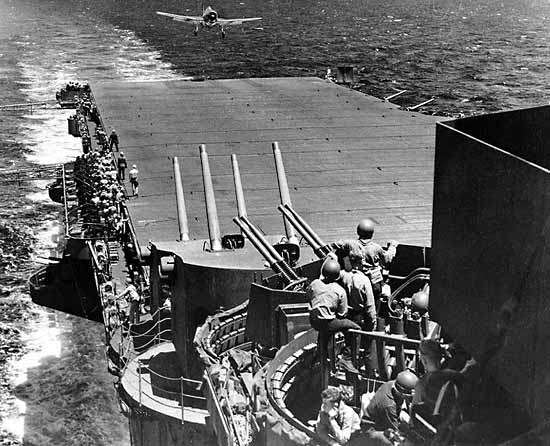Ahoj, bylo to velke strileni krocanu, ne holubu 
19.6. 1944 Battle of the Philippine Sea
Categories: Second World War , Calendar

The Battle of the Philippine Sea in June 1944 ended in disaster for the Japanese Air Force.TheJapanese lost about 300 aircraft in a single day in what became known as the "pigeon shoot in the Marianas."
The Battle of the Philippine Sea in June 1944 demonstrated the relative powerlessness of the Imperial Navy's carrier corps. Although the Japanese deck planes continued to have a longer range advantage, which the Japanese attempted to exploit. Nevertheless, the action of four large strike waves sent by the Japanese against the American carriers ended in disaster. Using F6F Hellcat fighters that performed better than the aging Zeros, better-trained pilots, and sophisticated use of radar to control the fighters, the Americans destroyed 19.
American submarines sank the new Taihō and the veteran Shokaku, while deck planes destroyed the Hōjō. "The Battle of the Philippine Sea marked virtually the end of the Imperial Navy's carrier corps, and the U.S. carrier corpsbecame the vanguard of the final assault on Japan," writes Mark Stille in his book, U.S. Aircraft Carriers vs. Japan's Aircraft Carriers.
Meanwhile, the Japanese fleet was heading into the Philippine Sea with the intention of destroying the U.S. naval forces alliedm attack aircraft from carriers and the islands - although nearly all the aircraft on the islands had already been destroyed by US naval aviation. Admiral Raymond Spruance took up a position west of Tinian, where his fleet became the target of an air attack on the morning of June 19.
Waves of planes from Japanese carriers were detected by radar and met by hundreds of American fighters. Most of the Japanese aircraft that survived were shot down by anti-aircraft fire from American ships or destroyed while attempting to land on the island's airstrips. The Japanese lost about 300 aircraft in a single day in what became known as the "pigeon shoot in the Marianas." The two Japanese carriers already mentioned were sunk by American submarines.
On the afternoon of the second day, the commander of theAdmiral Marc Mitscher to attack the Japanese fleet from an extraordinary distance. The planes sank a carrier and damaged other warships at the cost of small losses, but during the night return many of them ran out of fuel and crashed.
Mitscher ordered the fleet to "turn on the lights" so the pilots could find their way home. "Losses amounted to 80 aircraft, although most of the crews were rescued. Meanwhile, a fierce battle continued on Saipan into July, ending in mass suicides of Japanese soldiers and civilians," R. G. Grant writes in Battles: 5000 Years of Warfare.
Sources:
Mark Stille, US Aircraft Carriers vs. Japanese Aircraft Carriers
Mark Stille, US Navy Aircraft Carriers 1942-45
R. G. Grant, Battles: 5000 Years of Warfare
www.britannica.com
The article is included in categories:
Post
Děkuju za poznámku  Tak to se musím mrknout až budu doma, jak je to v knížce. A jestli jsem krocany zaměnila za holuby, tak nevím, kde jsem na to došla
Tak to se musím mrknout až budu doma, jak je to v knížce. A jestli jsem krocany zaměnila za holuby, tak nevím, kde jsem na to došla 
tak v knížce je opravdu „střelba na holuby na Marianách“ 
Njn, ja mam tohle bojiste relativne nacteno a vsude sou krocani 






